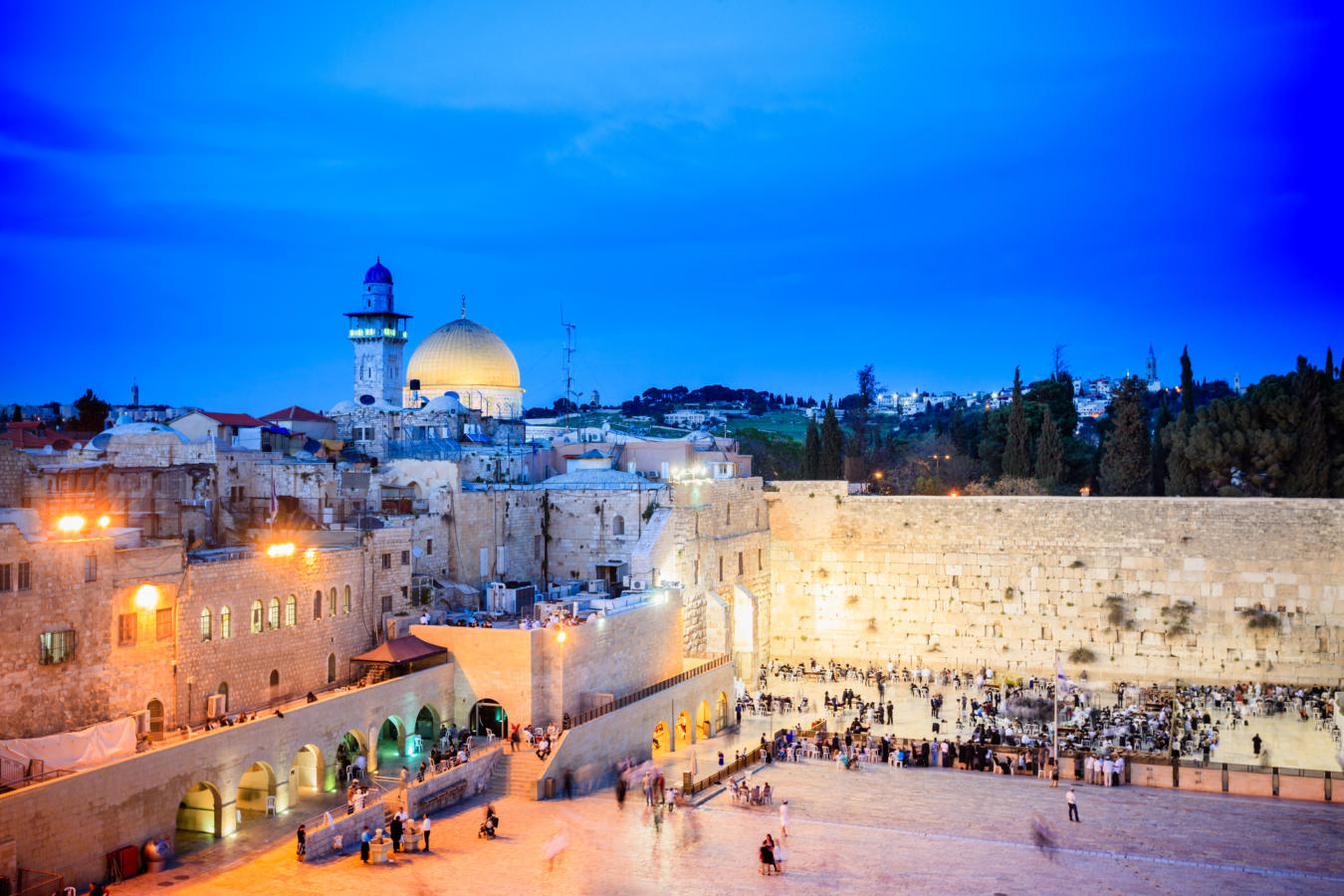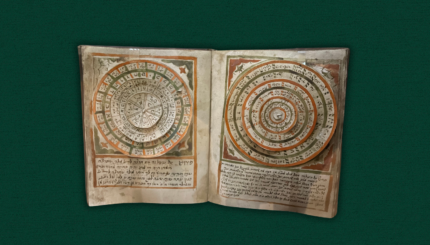With the sound of shattering glass at the conclusion of the wedding ceremony, generations of Jews were reminded that Jerusalem was destroyed and the Jewish people were in exile. With this ritual the vow recorded in book of Psalms was actualized: “If I forget thee Oh Jerusalem, let my right hand wither, let my tongue stick to my palate if I do not remember you, if I do not set Jerusalem above my greatest joy” (Psalm 137).
READ: What We Talk About When We Talk About Jerusalem
While we are overjoyed for the couple, at the same time, we remember that this small shattering glass is filled with sad memories mixed with hopeful dreams.
Yehuda Amichai, a well-known Israeli poet, wrote about remembering Jerusalem in a collection called “Songs of Zion the Beautiful“:
With your help, My Jewish Learning can provide endless opportunities for learning, connection and discovery.
Jerusalem’s a place where everyone remembers
he’s forgotten something
But doesn’t remember what it is.
This spiritual process of longing to remember and thereby touch that which is eternal is the essence of Judaism! And this remembering always connects to Jerusalem in one way or another…
Jerusalem in the Bible
While referred to a number of times in early biblical accounts from Abraham to Joshua, Jerusalem has been the central city of Judaism since the year 1000 B.C.E., when King David conquered this small, remote Canaanite town and made it the capital of his kingdom. With the building of the Temple by King Solomon following the death of King David, the city becomes the focus of three pilgrimages each year for thousands of Jews celebrating the festivals of Passover, Shavuot and Sukkot. These pilgrimages are in keeping with the command in the Torah to visit and worship “…in the place that God will choose, for the Lord God blesses you with produce and blesses the work of your hands and you shall rejoice” (Deuteronomy 16:16).
Jerusalem is a major focus of biblical literature and the likely venue where much of this literature was written and preserved. The kings of Judah lived and died here, as recorded in the Books of Samuel, Kings and Chronicles. Prophets were based in Jerusalem, interpreting the Torah and establishing the great moral and ethical standards of Judaism. The Book of Lamentations, often attributed to the prophet Jeremiah, laments over the destruction of First Temple by the Babylonians in 586 B.C.E. The destruction of the First Temple and the rebuilding of the Second Temple (60 years later) are recorded in the books of Kings, Ezra, Nehemiah and Chronicles.
Following the biblical accounts, the Second Temple period added 500 more years of memories. These memories are recorded in many of the Apocryphal books, such as the books of the Maccabees, relating the events (mostly in the Jerusalem area) leading to and following the revolt against the Greeks in the second century B.C.E. (commemorated during the Hanukkah festival).
With the rise of the Roman Empire, the city of Jerusalem grew and underwent a major facelift by Herod, the Roman appointed Jewish king who conquered Jerusalem with a Roman army in the year 37 B.C.E. Rabbinic literature records hundreds of events, stories, and descriptions of life in Jerusalem from this period.
Jerusalem in Rabbinic Judaism
After the destruction of the Second Temple in Jerusalem, the memory of the city came to embody the hopes and aspirations of the Jewish people within the developing tradition of Rabbinic Judaism. Jerusalem was now an ideal that represented redemption, perfection, and wholeness that Jews would study about, pray for, and try to spiritually experience from afar. While Earthly Jerusalem may be in ruins, controlled by foreigners and unreachable, Heavenly Jerusalem was in every Jew’s heart, waiting in the wings for the Messianic day when the promise of rebuilt Jerusalem would be fulfilled by God.
How were the Jewish people to keep these memories and hopes alive and part of their lives?
Jerusalem in Liturgy and Ritual
A series of “reminders” (rituals, prayers, and special days) developed in Jewish antiquity and were designed to keep the memory of Jerusalem alive from generation to generation, for example:
-Jerusalem is a central theme in Jewish liturgy and religious poetry. For example, one of the 19 blessings of the Amidah (silent prayer central to all Jewish prayer services) reads: “Return to Your city Jerusalem in mercy, and establish Yourself there as you promised…Blessed are you Lord, builder of Jerusalem.” The Amidah prayer is traditionally recited three times a day, while facing Jerusalem.
-Synagogues traditionally face toward Jerusalem.
-At the end of Passover seder and at the conclusion of Yom Kippur, we exclaim “L’shanah haba’ah b’Yerushalayim—Next Year in Jerusalem.” (In Israel, one concludes, “L’shanah haba’ah b’Yerushalayim habenuyah” — “Next year in the rebuilt Jerusalem.”)
-On Tisha B’Av, the Ninth of Av, we mourn for the destruction of both Temples, sitting on the floor of the synagogue to read the Book of Lamentations to a haunting cantillation.
In addition to ritual “reminders of Jerusalem,” many contemporary Jewish practices, customs, and beliefs can be traced to Jerusalem, providing a constant “meta-message” of the primacy of Jerusalem for anyone who scratches the surface. For example, the order of the synagogue service is modeled after the daily Temple service (Avodah) in Jerusalem. The weekly reading of the Torah was established in Jerusalem after the return from the first exile. The seder meal on Passover is based on seders held by generations of Jewish pilgrims in Jerusalem. There are many more examples of home rituals, burial practices, and synagogue practices that can be traced to Jerusalem.
Jerusalem as a Focus of Pilgrimage and Worship
During the centuries following the destruction of the Second Temple in 70 C.E., the Jewish connection to Jerusalem was mostly one of distant hope, but there was always a core of people waiting to visit and live in the city whenever the opportunity presented itself. According to the Church Father Jerome, the Jews of the fourth century would pay for the special privilege of entering Jerusalem on the Ninth of Av in order to mourn. The desire to stand as close to the area on which the Temple stood established the Western Wall area as a focus of pilgrimage and worship from as early as the seventh century.
In 1099, Jews and Muslims fought the Crusader invasion together, standing side by side on the walls of Jerusalem. The great rabbi Nachmanides arrived in the city from Spain between 1265-67, establishing a synagogue that still exists, the kernel around which the present Jewish Quarter grew. By 1844, the Jewish community was the largest single community in Jerusalem, numbering 7,120 people (almost one half of all inhabitants).
In modernity, the powerful pull of Jerusalem is expressed in the memoirs of Natan Chofshi, one of the early Zionist pioneers who arrived in the Land of Israel 100 years ago from Russia:
I used to pray…for the return to Zion…I particularly recall the prayers during Rosh Hashanah… ‘And on that day the horn will blow proclaiming the return of the lost in Assyria and Egypt and their return to the holy mountain of Jerusalem.’ These were sentences my father repeated at the holiday table. I was deeply affected by both the content and the tune of these words, and the tune resounds within me to this day. Thus I undertook the task of combining my own modest abilities and my best efforts…to hasten salvation.
And now, in our lifetime, we live with the reality of Jerusalem as the capital city of the Jewish State of Israel. This did not just come about on its own, but is the result of the Jewish people’s active remembering of Jerusalem throughout the generations, leading to the deeds of pioneers such as Nachmanides and Natan Chofshi. In this way, the prophet Zechariah’s words have been fulfilled: “Thus says the Lord of Hosts: The day will come when old men and old women will populate the streets of Jerusalem…And the streets of the city will fill with boys and girls at play” (Zechariah 8:4).
Av
Pronounced: ahv, Origin: Hebrew, Jewish month usually coinciding with July-August.
seder
Pronounced: SAY-der, Origin: Hebrew, literally "order"; usually used to describe the ceremonial meal and telling of the Passover story on the first two nights of Passover. (In Israel, Jews have a seder only on the first night of Passover.)
Torah
Pronunced: TORE-uh, Origin: Hebrew, the Five Books of Moses.



